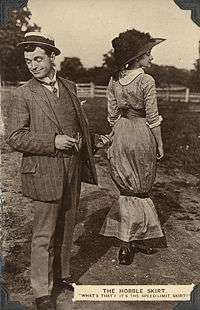Hobble skirt

A hobble skirt was a skirt with a narrow enough hem to significantly impede the wearer's stride. It was a short-lived fashion trend that peaked between 1908 and 1914.[1]
History



The hobble skirt may have been inspired by one of the first women to fly in an airplane.[2] At a 1908 Wright Brothers demonstration in Le Mans, France, Mrs. (Edith) Hart O. Berg asked for a ride and became the first American woman to fly as a passenger in an airplane, soaring for two minutes and seven seconds.[2][3] She tied a rope securely around her skirt at her ankles to keep it from blowing in the wind during the flight. According to the Smithsonian Air and Space Museum, a French fashion designer was inspired by the way Mrs. Berg walked away from the aircraft with her skirt still tied and created the hobble skirt based on her ingenuity.[3]
The French fashion designer in the Berg story might have been Paul Poiret[2] who claimed credit for the hobble skirt, but it is not clear whether the skirt was his invention or not.[4] Skirts had been rapidly narrowing since the mid-1900s.[4] Slim skirts were economical because they used less fabric.[4]
The hobble skirt became popular just as women were becoming more physically active.[4]
Hobble skirts inspired hundreds of cartoons and comic postcards.[4] One series of comic post cards called it the "speed-limit skirt."[2] There were several reports of women competing in hobble skirt races as a joke.[4]
Boarding a streetcar in a hobble skirt was particularly difficult. In 1912, the New York Street Railway began running hobble skirt cars with no step up.[2] Los Angeles introduced similar streetcars in 1913.[5]
Hobble skirts were directly responsible for several deaths.[2] In 1910, a hobble-skirt-wearing woman was killed by a loose horse at a racetrack outside Paris.[2] A year later, eighteen-year-old Ida Goyette stumbled on an Erie Canal bridge while wearing a hobble skirt, fell over the railing, and drowned.[2]
To prevent women from splitting their skirts, some women wore a fetter or tied their legs together at the knee.[1][6] Some designers made alterations to the hobble skirt to allow for greater movement.[4] Jeanne Paquin concealed pleats in her hobble skirts while other designers such as Lucile offered slit or wrap skirts.[4]
The hobble skirt trend died out at the beginning of World War I, as the skirt's limited mobility did not suit the wartime atmosphere.[7]
In popular culture
Movies and television series
- Intolerance: The Dear One (Mae Marsh) wears a makeshift hobble skirt in the hopes of impressing a man.
- The Addams Family: Morticia commonly wears long, black gothic hobble dresses.
- Darkwing Duck: Darkwing Duck's girlfriend, Morgana Macawber commonly wears a long, red hobble dress.
- Dick Tracy: Breathless Mahoney (Madonna) appears in a shiny black skintight gown.
- Ugly Betty: In the episode "Icing on the Cake" Amanda (Becki Newton) wears a tight silver rubber hobble dress named the "Amanda".
- What a Way to Go!: Louisa May Foster (Shirley MacLaine) is seen in shiny red pencil hobble skirt.
- Static Shock: Daisy Watkins wears a purple pencil hobble skirt in the first few seasons of the show.
- Parade's End: Sylvia Tietjens wears a hobble dress to her mother-in-law's funeral, c. 1912 (episode 2); the gentry disapprove of her stylishness, but the servants admire it.
Music videos
- "Love Religion" — U96
See also
References
- 1 2 F, José Blanco; Hunt-Hurst, Patricia Kay; Lee, Heather Vaughan; Doering, Mary (2015-11-23). Clothing and Fashion: American Fashion from Head to Toe [4 volumes]: American Fashion from Head to Toe. ABC-CLIO. ISBN 9781610693103.
- 1 2 3 4 5 6 7 8 David, Alison Matthews (2015-09-24). Fashion Victims: The Dangers of Dress Past and Present. Bloomsbury Publishing. ISBN 9781472577733.
- 1 2 "Women in Aviation and Space History - Smithsonian National Air and Space Museum". airandspace.si.edu. Retrieved 2017-09-01.
- 1 2 3 4 5 6 7 8 Milford-Cottam, Daniel (2014-02-10). Edwardian Fashion. Bloomsbury Publishing. ISBN 9780747814757.
- ↑ Walker, Jim (2007). Los Angeles Railway Yellow Cars. Arcadia Publishing. ISBN 9780738547916.
- ↑ "::: Fashion Plate Collection :::". content.lib.washington.edu. Retrieved 2017-09-01.
- ↑ "Hundred-Year-Old Fashion Fad: The Hobble Skirt". 2014-09-22. Retrieved 2017-09-01.
External links
| Wikimedia Commons has media related to Hobble skirt. |
- The Hobble Skirt Streetcar, streetcars designed with women wearing these skirts in mind